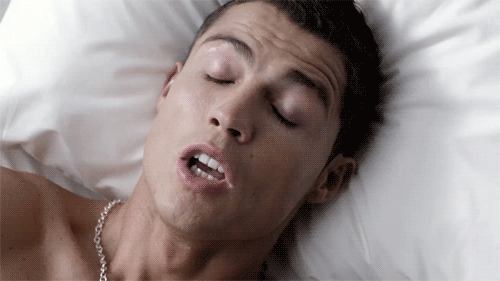Getting High Off of Breath Therapy
Heavy breathing to a techno beat can be like tripping on hallucinogenic drugs.
There are ten of us here, all sitting on our own mattress in a function hall in Aarhus, Denmark. The floor is full of drums, rattles, and tambourines, and we've each been given a blindfold and a sick bucket. Five aides are on hand to support us through the journey we're about to embark on, hyperventilating our way to what's supposedly going to be the best high of our lives.
Our instructor, psychotherapist Bjarne Roursgaard, is on the floor, too, facing us and putting the last touches to a techno playlist he's carefully curated for the occasion. Once that's done, he takes us through a few basic guidelines. "Just let go completely," he tells us. "Don't worry about what others here may think—we’ve seen every possible reaction." He goes on to list the wide range of emotions participants before us have gone through. "Anger, grief, joy. Even sexual arousal." He tells us that whatever feelings arise during the session, we should just go with it. "Express them so you're able to let go of any trauma and feelings pent up inside your body."
Breath therapy is sold as a trip similar to the kind you'd have on hallucinogenic drugs, only its disciples believe it offers a much more powerful high and won't fuck with your mind the way drugs might. It's a relatively simple process: You just hyperventilate to the point that the blood in your brain starts getting oversaturated with oxygen, before becoming so dizzy that it seems like you're drifting off into another dimension.
Czech psychiatrist Stanislav Grof, 86, is one of the earliest pioneers of psychedelic therapy—using hallucinogenics to help treat a range of psychological issues. In his research, Grof claims that using LSD can be an effective way to treat anxiety and depression in terminally ill patients. However, after many countries began criminalizing acid in the 1960s, he and his wife Christina started working with a less controversial tool: breathing. The pair found that breath therapy had the potential to expand consciousness in the same way as LSD, and could potentially help patients overcome—or at least come to terms with—all manner of personal traumas.
In the hall in Aarhus, Roursgaard is taking us through some more exercises. He tells us he studied chemical engineering, but retrained as a psychotherapist, and is currently working with a "Peruvian shaman" to hone his expertise in what he refers to as "Shamanistic Breath Therapy."
Roursgaard's particular brand of therapy is inspired by Grof's concept of Holotropic Breathing—a technique that can involve up to three hours of fast, deep, and heavy breathing. In our session, we do all that in sync with the techno playlist he's put together. As part of his more extensive weekend sessions, the psychotherapist also offers participants ayahuasca—but he claims there's no real need for it. "I’ve seen people go deeper with breath therapy than with ayahuasca," he tells me.
I start the session by lying on my back and putting on the blindfold. The bass emanating from the two speakers on the floor pounds through me, as Roursgaard’s assistants walk around the room, banging on drums and shaking rattles. As the music gets louder, I try to concentrate on exhaling deeply from my diaphragm in time with the music, while resting my arms along the sides of my body.
The second my breathing starts slowing down and falls behind the beat, an assistant appears and hovers directly over me, instructing me to get back in sync. After about ten minutes, I begin to feel dizzy but still relatively normal—very much conscious and in control of my own emotions.
Soon after, the rest of my body starts feeling the effects of the session. At first, I notice small spasms in my chest. I try directing my breathing toward them—and, almost as soon as I do, I'm overcome with rage and start screaming. Uncontrollably, my thoughts turn to six months ago, when my girlfriend of 13 years and I broke up. This sudden wave of rage seems linked to that breakup, though I've never felt it before. It's a completely new, incredible experience, so I decide to just completely let go—to give in to any emotions popping up inside me.
My screams are almost completely drowned out by all the noises coming from others in the room. I hang back for a second while maintaining my breathing. I feel my fingers cramping up—a sensation I was expecting, as the oxygen in my body is only interested in getting to my brain.
I then notice a kind of tremor right above my heart. I focus on hyperventilating again, but however deeply I inhale and exhale, nothing seems to be happening. Seconds later, one of the aides hovers over me again, gently leans down and places two fingers on my chest—right between my ribs. Almost immediately I release a massive roar from deep within me, as tears start running down my cheeks. It feels good, though I don’t really know where it’s all coming from, or why.
There's some research supporting the idea of breath therapy, like a study by a researcher at Stanford University, which found that symptoms of PTSD in a group of war veterans were drastically reduced after a series of breath therapy sessions. Another study by the Multidisciplinary Association for Psychedelic Studies (a nonprofit working to raise awareness and understanding of psychedelic substances) reviewed responses from 482 volunteers who had done breath therapy, and found that 82 percent of the participants had so-called transpersonal feelings—out-of-body experiences that seemed to transcend the boundaries of what it means to be an individual. Sixteen percent of participants described feeling some effects, while the remaining 2 percent didn't experience anything at all.
Back on my mattress in Aarhus, I’m definitely experiencing something. I can't stop crying, when all of a sudden, I start laughing. For the first time since the session started, I wonder if I'm just losing my mind. Once again, though, I decide to fully embrace the emotions swirling around in my body and go full in with the laughter.
When our 50-minute session is up, we're instructed to use the next 20 minutes to relax and slowly return our breathing to normal. Throughout the trip, I've remained aware of the fact that I could return to my normal state of being by simply removing my blindfold.
I can't say for sure what exactly happened to me when I hyperventilated, but I feel lighter in both body and mind. I also experienced emotions I never knew I had, or knew how to get in touch with, just by flexing my lungs over a techno beat.



